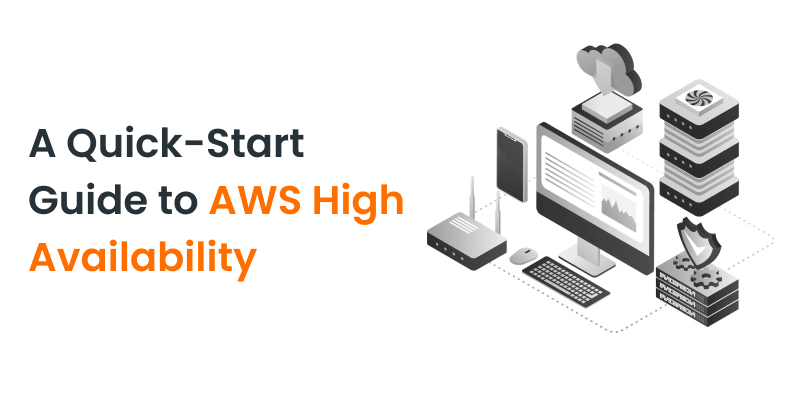
A Quick-Start Guide to AWS High Availability
In today’s rapidly evolving digital landscape, where even a few moments of downtime can result in substantial financial losses and irreparable damage to a company’s reputation, achieving high availability (HA) for your applications and services is no longer just a goal – it’s a necessity. The cloud computing era has brought forth new opportunities and challenges, and Amazon Web Services (AWS) stands as a pioneering solution to address these needs.
In this comprehensive guide, we will delve into the intricate world of high availability within the AWS ecosystem, exploring the fundamental concepts, innovative strategies, practical implementation steps, key challenges, and best practices to ensure seamless operations in the face of adversity. This guide serves as an invaluable resource, almost like your personalized AWS Course, providing a deep understanding of high availability strategies in the context of Amazon Web Services.
Table of Contents:
- Understanding High Availability in AWS
- Strategies for Achieving High Availability
- Quick Steps to Implement AWS High Availability
- Challenges and Considerations
- Best Practices for AWS High Availability
- Conclusion
Understanding High Availability in AWS
At its core, high availability in AWS revolves around the notion of resilience – the ability of a system to continue functioning, even when one or more components experience failures. AWS understands the paramount importance of this concept and offers an array of services and tools to empower users in building robust, fault-tolerant architectures.
Strategies for Achieving High Availability
There are a few strategies for achieving high availability. They are:
1. Multi-Availability Zone (AZ) Architecture:
An Availability Zone in AWS represents a discrete data center, furnished with its power, cooling, and networking capabilities. Designing your architecture to span multiple AZs serves as a foundational strategy for high availability. By distributing resources across various Availability Zones, you are safeguarding your application against disruptions arising from hardware malfunctions, natural disasters, or other unforeseen events that might afflict a single zone.
2. Multi-Region Architecture:
While Multi-AZ configurations provide an impressive degree of resilience, some scenarios might demand a more robust strategy. This is where the concept of multi-region architecture comes into play. By deploying your application across multiple AWS regions, you mitigate the risk of widespread outages that could potentially affect an entire region. This approach underlines AWS’s global footprint, allowing you to build a solution that spans continents.
3. Load Balancing:
Elastic Load Balancers (ELBs) are a linchpin of AWS high availability strategies. These load balancers evenly distribute incoming traffic across instances located in different AZs or even distinct regions. This not only enhances fault tolerance by avoiding any single point of failure but also optimizes the utilization of resources, leading to improved performance and scalability.
4. Auto Scaling:
In a world where application demand can fluctuate drastically, having the ability to scale your resources dynamically is indispensable. AWS Auto Scaling is a service that monitors your application’s traffic and adjusts the number of instances automatically. This ensures that your application can gracefully handle variations in load, thereby maintaining optimal performance and availability.
5. Database Replication:
Data lies at the heart of most applications, making database availability a critical concern. Services like Amazon RDS (Relational Database Service) and Amazon DynamoDB offer mechanisms for database replication. By maintaining database copies in different AZs or even regions, you guarantee not only data durability but also availability in the event of a failure.
Quick Steps to Implement AWS High Availability
Some of the steps to implement AWS high availability are the following:
- Step 1: Choose Your Region and Availability Zones
The initial step in your high availability journey involves selecting the appropriate AWS region(s) for your application. This decision should be influenced by factors such as geographical proximity to your user base and regulatory considerations. Furthermore, distribute your resources across multiple Availability Zones within each region to create redundancy and reduce the impact of failures.
- Step 2: Distribute Traffic with a Load Balancer
Setting up an Elastic Load Balancer (ELB) is paramount to evenly distribute incoming traffic across instances located in different Availability Zones. By doing so, you proactively prevent any single instance from becoming a potential point of failure. Moreover, ELBs enhance fault tolerance by automatically rerouting traffic to healthy instances in the event of a failure.
- Step 3: Replicate Your Data
If your application involves databases, implementing robust data replication mechanisms is crucial. Amazon RDS, for instance, offers Multi-AZ deployments that automatically maintain a synchronized standby instance in a separate Availability Zone. In the event of a primary instance failure, the standby instance can be seamlessly promoted to take over, ensuring minimal downtime and data loss.
- Step 4: Implement Auto Scaling
Leveraging AWS Auto Scaling allows your application to respond dynamically to fluctuations in traffic. Configure scaling policies based on predefined metrics, and let AWS manage the number of instances in your fleet. This not only optimizes resource utilization but also enhances availability by ensuring your application can meet changing demands without manual intervention.
- Step 5: Monitor and Test
Even the most well-designed high-availability architecture requires ongoing vigilance. Set up robust monitoring using AWS CloudWatch to keep a watchful eye on the health and performance of your resources. Additionally, regularly conduct failover tests to validate the effectiveness of your HA setup and identify potential areas for improvement.
Challenges and Considerations
While AWS offers a comprehensive toolkit to enable high availability, there are challenges and considerations that merit attention:
1. Data Consistency:
In distributed systems, maintaining data consistency can be intricate. Choose database and service options that align with your application’s consistency requirements. Striking the right balance between availability and consistency is key to a successful implementation.
2. Cross-Region Latency:
When designing multi-region architectures, be prepared to contend with potential latency between regions. This can impact real-time applications that rely on rapid data synchronization. Consider using techniques like asynchronous replication to manage this challenge effectively.
3. Cost:
Achieving high availability often necessitates redundancy – multiple instances, databases, and even regions. While the investment is justified by the benefits, it’s crucial to carefully assess and manage the associated costs to ensure alignment with your organization’s budget.
4. Complexity:
Highly available architectures, while invaluable, can introduce complexity. The deployment, management, and monitoring of these setups might require specialized expertise. Adequate training and ongoing skill development are imperative for the successful implementation and maintenance of HA systems.
Best Practices for AWS High Availability
The various best practices for AWS high availability are discussed below:
1. Design for Failure:
Embrace the philosophy of “design for failure.” Assume that failures are inevitable and architect your application to handle them gracefully. This might involve building stateless applications, leveraging managed services, and implementing strategies like circuit breakers to isolate components during failures.
2. Use Managed Services:
AWS offers an extensive portfolio of managed services that abstract the complexities of infrastructure management. Services like Amazon RDS, AWS Elastic Beanstalk, and Amazon ECS allow you to focus on crafting resilient applications while AWS handles the underlying operational intricacies.
3. Implement Proper Monitoring:
Establish robust monitoring and alerting mechanisms to gain insights into the health and performance of your resources. AWS CloudWatch provides a suite of tools to monitor metrics, set up alarms, and trigger automated responses to anomalies, ensuring proactive issue resolution.
4. Regularly Test Your HA Architecture:
A high-availability architecture is only as strong as its weakest link. Regularly conduct failover tests to verify the effectiveness of your setup. Simulating various failure scenarios allows you to identify potential gaps and bottlenecks and refine your strategy accordingly.
5. Automate Everything:
Leverage the power of Infrastructure as Code (IaC) tools like AWS CloudFormation to automate the provisioning and management of your resources. Automation guarantees consistency, reduces the risk of human errors, and accelerates the deployment of your HA architecture.
Conclusion
In an era where digital services form the backbone of business operations, the pursuit of high availability is no longer a mere aspiration; it’s a critical requirement. AWS’s robust suite of services empowers organizations to create fault-tolerant architectures that can withstand the challenges posed by the unpredictable nature of technology.
Remember, the pursuit of high availability is an ongoing commitment, demanding vigilant monitoring, regular testing, and a proactive attitude towards adaptation as your application continues to evolve and thrive in the dynamic digital landscape.






